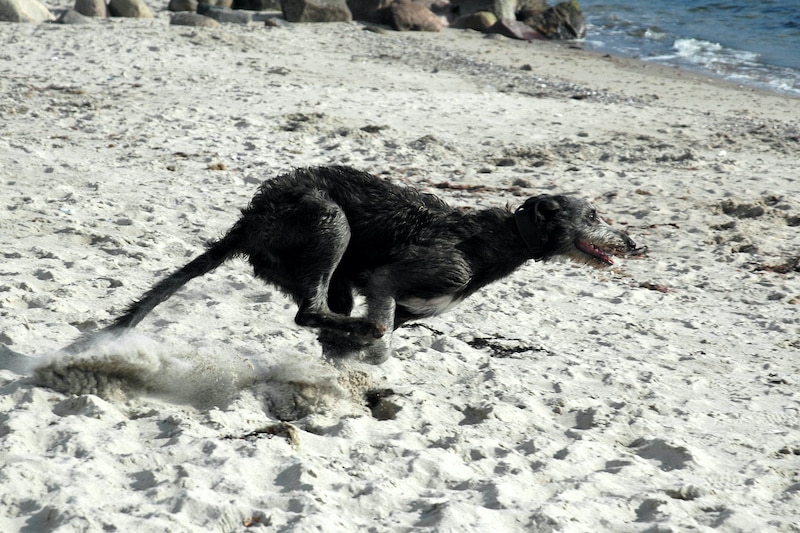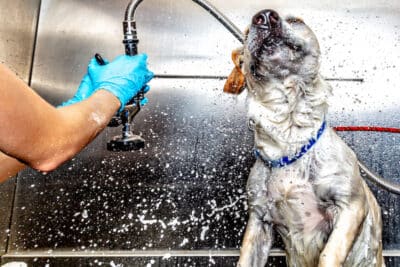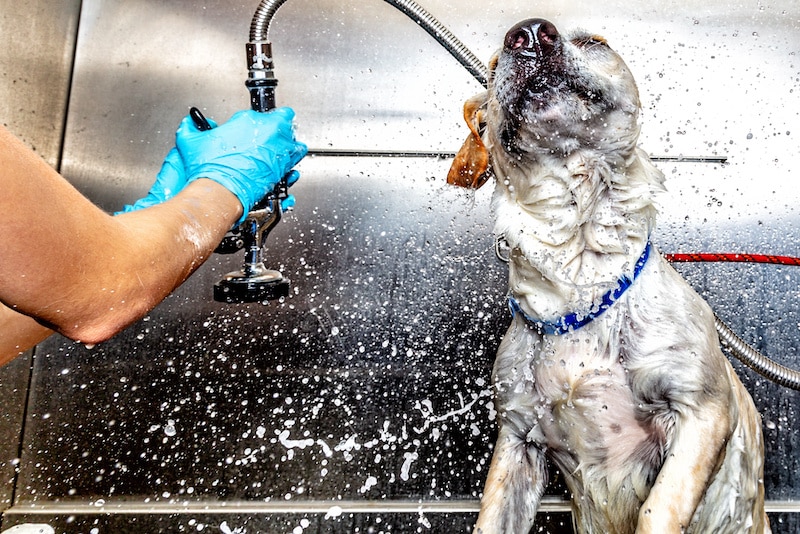The Scottish Deerhound is a gentle giant that’s similar to the Greyhound and Irish Wolfhound. They’re known for loving short bursts of activity, as well as relaxation time with the family.
Do they shed much? The Deerhound is a moderate shedding breed that sheds constantly throughout the year. And because they’re such a large breed with longer hair, the amount of hair loss can be quite noticeable. However, their coat is relatively easy to groom, so keeping this under control shouldn’t be a problem.
Let’s take a closer look at this noble hound to find out what sort of hair loss you should expect, what they’re like to groom and more.
Recommended: Go here to see our top-rated dog hair blow dryers
Scottish Deerhound Shedding
The Scottish Deerhound (or Deerhound) is a moderate shedding breed.
To help put this into perspective, they’re somewhere between a high shedding breed (like a Mountain Dog) and a low shedding breed (like a Basenji) in terms of how much hair they lose.
However, because their coat is about 3-4 inches long, rough and wiry, the hair they do lose is typically going to be more noticeable than a dog with shorter, finer hair.
And, like most dogs, they tend to shed more during certain times of the year such as spring and autumn as their coat adjusts to the change in temperature. This is known as blowing coat.
So you should expect to be cleaning up loose hairs fairly regularly throughout the year, but it’s nothing that can’t be handled with a regular grooming regime.
What Are Deerhounds Like to Groom?
Deerhounds are fairly easy to groom compared with most longer haired breeds, but will still require more effort than a short coated breed like a German Shorthaired Pointer for example.
They have rough, wiry coats that are about 3-4 inches (about 7-10 cm) in length, which served them well during their early days of cold, harsh conditions in Scotland.
To keep your Deerhound’s coat in top shape, it’s best to brush him with a slicker or pin brush a few times per week, and follow that up with a Greyhound comb to remove any matts and tangles.
A Greyhound comb is just a brand name for a metal comb that typically has widely spaced teeth on one half of the comb, and more tightly packed teeth on the other half.
Brushing actually has a couple of main benefits when it comes to shedding. The first and most obvious one is that it removes the dead hairs from your dog’s coat. The second benefit is that it helps to distribute the natural coat oils, which helps defend against dry skin, a leading cause of excessive shedding.
So it’s well worth brushing on a regular basis with respect to reducing shedding. And of course, it helps to keep your Deerhound looking amazing.
Recommended: Go here to see our top-rated dog hair blow dryers
Are Scottish Deerhounds Hypoallergenic?
No, Scottish Deerhounds are not hypoallergenic.
And therefor they are not the best choice for allergy sufferers. However, no dog is ever truly hypoallergenic, even completely hairless dogs can cause allergies.
This is because the allergies actually don’t come from the hair itself, they come from the saliva and dead skin (dander) of the dog. And that attaches itself to the hair, which inevitably spreads the allergens more when more dead hairs are floating around.
But as far as “hypoallergenic breeds” are concerned, meaning the dogs that cause the least issues for people with allergies, they’re not the best.
If this is your concern, a more suitable breed would something like an Afghan Hound, Schnauzer or Poodle for example.
Reducing Excessive Shedding
Most dogs shed hair, so this is completely normal and not something you want to try to stop completely. But you can reduce the amount of hair your dog sheds and how much of that hair ends up around your home significantly.
The first way to do this is by brushing your Scottish Deerhound regularly. Typically a few times per week with a good quality slicker brush is fine, but you may want to step this up to everyday if you’re really noticing a lot of loose hairs on the floor.
You could also try a deshedding tool which is purpose built to remove excess hair and can work very well. However, given the Deerhounds coat, it’s probably best to start with a pin brush or slicker brush first to remove any matts and tangles.
As mentioned, regular brushing doesn’t just remove the dead hair, it also helps to spread your dog’s coat oils evenly over his coat, which keeps the coat moisture rich and in good health.
Aside from brushing, a proper diet, along with regular exercise, can help. And as part of that, you could even try a home remedy like coconut oil or olive oil to further reduce shedding.
Should You Adopt a Deerhound?
Standing 32 inches tall and weighing an average of 110 pounds, the Deerhound is a large dog that can be quite intimidating.
But they’re actually very gentle, friendly and affectionate towards people. Whether it be friends, family, or complete strangers.
And they’re fine to have around children, but it’s generally best to not leave them around small children unsupervised given their size.
They’re typically not aggressive towards other dogs either.
By nature, they’re more the quietly confident type that will stand their ground but won’t initiate. However, they were used as hunters back in the day, so naturally when it comes to smaller animals (like cats) they may give chase.
This is because the Deerhound is classified as a “hound” (specifically sighthound), which love chasing small, fast moving objects or animals they consider prey. So this is something to keep in mind.
As far as exercise goes, they can be quite active as puppies but after the age of 5, tend to become more docile and happy to lounge about. They do need regular exercise, off leash, though.
So this is definitely not a good breed if you live in an apartment, unless you plan on taking him to a park where you can safely let him run freely.
The other thing to consider is that, given their friendly, quiet and somewhat docile nature, they don’t make the best watchdogs. If that’s what you’re looking for, consider a breed like the Doberman.
What’s Their Heritage?
The Scottish Deerhound was bred to hunt red deer in Scotland in the 16th century through a practice called coursing, where Greyhounds, Deerhounds and other sighthounds would hunt game for sport.
The practice involved chasing the prey by sight, rather than smell, and included animals like foxes, rabbits and deer among others.
This came to an end in 1745 though, when Scotland’s clan system collapsed, at which point they became sporting animals for landowners and the nobility. Given their appearance and status, they were commonly referred to as the “Royal Dog of Scotland” at the time.
Many people confuse Scottish Deerhounds with Irish Wolfhounds because there are so many similarities. As in, they’re both large, similar looking dogs and both are sighthounds
And they are actually related, because in the late 1800’s the Scottish Deerhound was used to recreate the Irish Wolfhound breed. So it’s an easy mistake to make.
But there are some distinct differences between the two breeds that differentiate them based on their lineage, personality traits and overall appearance. So these are different breeds.
In any case, eventually Scottish Deerhounds were bought to the United States. The first of which was named Bonnie Robin, who was registered by the American Kennel Club (AKC) in 1886.
And these days, Deerhounds can be found running furiously in the park or lazing around the home. These are pretty much their two favorite things to do.
Bottom Line
Scottish Deerhounds are moderate shedders that are pretty easy to groom. And they make great family companions for people who have some room to let them run about.
Even though they do shed year round, if you’re set on adopting a Deerhound, don’t let that put you off. Because it’s nothing that can’t be handled with a regular brushing routine. That, along with some of the other tips mentioned in this article, will help keep the hair at bay!













Please note: By submitting a comment using the above comment form, you confirm that you agree with the storage and handling of your data by this site as detailed in our Privacy Policy.